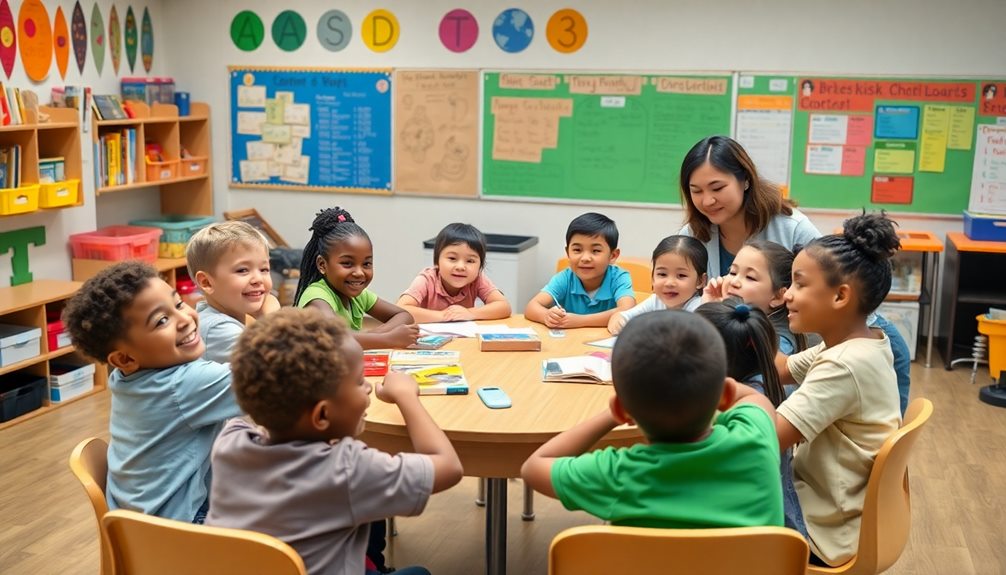Equity in education means providing each student with the unique resources and support they need to thrive. It goes beyond equality, which offers the same resources to everyone, and focuses on addressing individual challenges. This approach fosters student success, especially for marginalized groups who often face barriers like poverty or language challenges. When schools commit to equity, they create inclusive environments that promote engagement and a sense of belonging. As you explore further, you'll discover effective strategies and actions that can make this vision a reality in your local schools.
Key Takeaways
- Equity in education ensures that all students receive tailored resources and support based on their unique needs and circumstances.
- It aims to close achievement gaps by offering targeted interventions for marginalized groups, enhancing overall academic outcomes.
- Culturally responsive instruction reflects diverse backgrounds, fostering an inclusive learning environment that values every student's experience.
- Ongoing assessment and feedback are essential for adapting educational practices to better serve individual learners and address barriers to success.
- Engaging families and communities is crucial for supporting student learning and overcoming external challenges, such as poverty and food insecurity.
Definition of Educational Equity

In today's educational landscape, educational equity means guaranteeing every child gets the resources and support they need to thrive academically and socially, regardless of their background. It addresses disparities in performance by fostering environments where all students can achieve success.
Equity focuses on understanding individual needs and dismantling inequitable practices that prevent access to quality education. Unlike equality, which provides the same resources to everyone, equity tailors support systems based on specific circumstances. This means some students may require additional resources to help them succeed, while others may need different kinds of support.
By implementing tailored supports, schools can better meet diverse learning needs, allowing every student to reach their full potential. Culturally responsive instruction also plays a crucial role in educational equity. It guarantees that teaching methods and materials reflect the backgrounds and experiences of all students, making them feel valued and included.
Ultimately, educational equity isn't just about providing access to rigorous content; it's about creating an inclusive environment where every child can flourish, regardless of their unique challenges or advantages.
Importance of Equity in Education

Understanding the importance of equity in education means recognizing how individualized support can help each student thrive.
By closing achievement gaps, you're not just improving academic outcomes; you're also creating an inclusive environment that values every learner's unique needs.
This commitment to equity guarantees that all students have the resources they need to succeed, regardless of their background.
Individualized Student Support
Individualized student support plays an essential role in achieving equity in education by addressing the distinct needs, strengths, and challenges of each learner. This support recognizes that students come with unique needs that require tailored resources and personalized learning strategies.
By implementing differentiated instruction and targeted interventions, you can help guarantee that every student engages meaningfully with the curriculum.
Research shows that when schools adopt personalized learning approaches, they often see improved academic success, especially among historically marginalized groups. These strategies can greatly reduce achievement gaps, as they consider the diverse learning styles and backgrounds of students.
For instance, students facing barriers like poverty or unstable housing benefit from accommodations designed to meet their specific circumstances.
Moreover, continuous assessment and feedback are vital in this framework. By regularly evaluating student progress, you can adjust your strategies to better serve each learner's needs.
Ultimately, individualized support not only fosters educational equity but also empowers each student to reach their full potential, creating a more inclusive and successful learning environment for everyone.
Closing Achievement Gaps
Closing achievement gaps is an essential focus in the quest for educational equity. When you prioritize equity in education, you directly impact academic outcomes, especially for historically marginalized groups who face systemic barriers.
Research shows that schools dedicated to closing achievement gaps can considerably reduce performance disparities and enhance student success. Implementing effective strategies, such as targeted support for at-risk students, boosts their engagement and overall performance. This tailored approach helps address the unique challenges these students encounter, ultimately promoting equitable learning opportunities.
Additionally, schools can benefit from creating a retirement savings plan for educators, ensuring that teachers are financially secure and can focus on student success. By fostering inclusive learning environments, you create spaces where students from diverse backgrounds can thrive, leading to higher graduation rates.
Moreover, continuous assessment and adjustment of educational practices based on student feedback are essential in this process. You need to be adaptable, ensuring that your methods are responsive to the needs of all learners.
Equality vs. Equity Explained

In the domain of education, the concepts of equality and equity often get confused, yet they represent fundamentally different approaches.
Equality aims to provide all students with the same resources and educational opportunities, like ensuring everyone gets the same textbooks. However, this one-size-fits-all method doesn't consider individual needs or circumstances. To foster a more effective learning environment, schools can also implement top wellness tips that support students' overall health and well-being, which is essential for academic success.
On the other hand, equity focuses on individualized support tailored to each student's unique challenges. For instance, disadvantaged students might need extra tutoring or resources to overcome barriers like low income or language difficulties. This thoughtful approach creates learning environments that acknowledge the different starting points of each student, aiming for true academic achievement.
The key distinction lies in understanding that equality alone doesn't address systemic disparities. Just giving everyone the same access won't guarantee success.
Research shows that equity-focused strategies lead to better outcomes by ensuring that all students have the support they need to thrive. By prioritizing equity, schools can create a more just educational landscape, paving the way for all students to achieve their potential.
Challenges to Achieving Equity

Achieving equity in education is fraught with challenges that can hinder progress for many students. You mightn't realize how deeply factors like poverty impact educational equity. Many students face barriers to education due to their low-income backgrounds, which often limit their access to resources and opportunities.
Food insecurity is another critical issue; without basic needs met, students struggle to focus and perform academically.
Language acquisition also poses significant challenges. For students learning English, the inability to fully engage with the curriculum can create feelings of isolation and frustration.
Additionally, homelessness and unstable housing severely affect attendance and concentration, making it difficult for these students to succeed.
Emotional and behavioral issues stemming from experiences of abuse or neglect can further obstruct learning. These challenges may prevent students from reaching their potential, making it essential for schools to address these barriers to educational equity.
When schools understand what equity means in practice, they can better meet students' needs and create a more inclusive learning environment.
Ultimately, recognizing these challenges is the first step toward fostering true equity in education.
Benefits of Promoting Equity

When you promote equity in education, you'll notice improved academic outcomes for all students.
By creating diverse and inclusive learning environments, you enhance student engagement and foster a sense of belonging.
This supportive atmosphere not only boosts retention rates but also helps bridge achievement gaps among learners.
Improved Academic Outcomes
Promoting equity in education leads to markedly improved academic outcomes for all students. When schools prioritize equitable education, you'll notice a positive shift in performance across diverse demographics.
Here are three key benefits:
- Increased Resource Access: Students from historically marginalized backgrounds gain equitable access to resources, which greatly boosts their academic achievements compared to peers in less supportive settings.
- Targeted Interventions: By using data to identify performance disparities, educators can implement targeted interventions. This approach helps at-risk populations make measurable academic gains, fostering a sense of belonging and capability.
- Supportive Learning Environments: Schools that create nurturing environments focused on equity see heightened student engagement. This increased engagement correlates with better academic outcomes, benefiting everyone in the school community.
Ultimately, promoting equity not only enhances individual academic achievements but also cultivates a more cohesive school community.
As you support these initiatives, you'll witness firsthand the transformation in learning environments and the reduction of achievement gaps, paving the way for all students to thrive academically.
Enhanced Student Engagement
Creating an equitable educational environment boosts student engagement by fostering a sense of belonging and investment in the learning process. When you promote equity in schools, you're creating supportive classrooms where all students feel valued and understood. This inclusivity encourages active participation, allowing students to connect with their peers and engage more deeply with their education.
Research shows that diverse learning settings improve student leadership skills and motivation to excel academically. When students feel their unique needs are addressed, they're more likely to remain committed to their studies, leading to equitable outcomes for everyone.
Additionally, schools that focus on equity not only enhance student engagement but also experience lower dropout rates, as students perceive their educational environment as fair and responsive.
Engaging with diverse peers through equitable programs helps reduce prejudicial views and fosters tolerance, cultivating a more collaborative school culture. By prioritizing equity, you guarantee that every student has opportunities to thrive, resulting in improved academic outcomes.
Ultimately, an equitable educational environment not only boosts student engagement but also builds a foundation for lifelong learning and success.
Strategies for Implementation

Regularly evaluating school practices is essential for identifying and addressing inequities within the educational system.
By implementing effective strategies, you can promote equity in education for all students. Here are three key strategies for implementation:
- Training for Educators: Provide ongoing professional development focused on inclusive teaching methods and culturally responsive practices. This training helps educators understand diverse student backgrounds and needs.
- Community Engagement: Actively engage families and communities in the educational process. Establish partnerships that support student learning and address barriers, such as food insecurity and unstable housing.
- Monitor Progress: Regularly assess school practices and monitor student progress towards educational equity. Use data-driven decisions to evaluate the effectiveness of your strategies and adjust as needed based on student performance and feedback.
Resources for Educators

Accessing the right resources can greatly enhance your ability to promote equity in education. As an educator, you can take advantage of professional development opportunities focused on equity.
Creating a personal budget for educational resources can help you effectively manage funds for these initiatives. Training programs, workshops, and online courses provide valuable strategies for fostering inclusivity in your classroom. Consider enrolling in accredited teacher education programs, like those offered by National University, which emphasize equity-focused teaching practices, especially in Early Childhood Education.
Utilizing resources such as after-school programs and one-on-one tutoring can extend learning opportunities for students needing additional support. These initiatives help create a more equitable environment, guaranteeing every child has access to the educational tools they need to succeed.
Additionally, integrating educational technology can boost student engagement, but it's essential to guarantee equitable access for all students.
Community partnerships also play an important role in providing extra resources and support. They can help address issues like food insecurity, allowing you to focus on creating a more inclusive learning space.
Frequently Asked Questions
What Equity Really Means in Schools?
Equity in schools means recognizing and addressing each student's unique needs. It's about providing tailored resources and support, ensuring everyone has a fair chance to succeed academically and socially, regardless of their background or challenges.
Which of the Following Is an Example of Equity in Schools?
An example of equity in schools is when you provide extra support, like tutoring, for students facing unique challenges. It guarantees everyone has the resources needed to meet academic standards and thrive in their learning environment.
How to Define Educational Equity?
You define educational equity as providing tailored resources and support to each student, ensuring they can thrive academically and socially, regardless of their background. It focuses on meeting diverse needs to create equal opportunities for success.
What Is the Academic Definition of Equity?
Imagine a garden where every flower grows at its own pace. In academic terms, equity means providing tailored support to each student, ensuring they thrive based on their unique needs, rather than just offering the same resources.
Conclusion
In the vibrant tapestry of education, equity is the thread that binds us all together. By embracing and promoting equity, you're not just leveling the playing field; you're igniting a spark of potential in every student, paving the way for a brighter future. It's time to turn the tide and transform challenges into stepping stones. So, let's roll up our sleeves and weave a more inclusive, supportive educational experience for every learner who walks through our doors.










